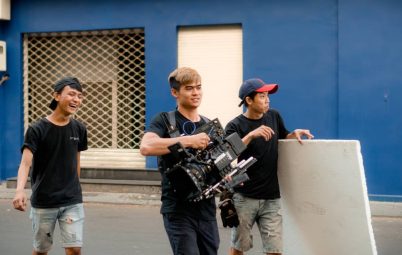Video has become one of the most powerful forms of content, and it’s easy to see why. It’s engaging, easy to consume and highly shareable. However, with so many platforms available, each with its unique audience and format, creating video content that performs well across multiple channels can be challenging. To avoid getting lost in the technicalities and effectively reach your target, consider the following aspects before producing video content:
- Platform-specific formats
One of the essential things to consider when creating video content is the platform-specific format. Each platform has its own unique requirements for video content. Creating videos with the correct format is imperative to optimise their performance across different channels.
- Audience
Your video’s audience varies according to the platform. For instance, TikTok’s audience is mostly younger, and their content style is more relaxed and imaginative. On the other hand, LinkedIn’s audience is more formal and business-oriented. Understanding each platform’s audience is crucial to creating content that resonates with them.
- Content duration
Another crucial aspect of creating video content is the duration of your video. The ideal video length varies by platform. For example, Facebook recommends videos shorter than two minutes, while YouTube can accommodate longer videos. In contrast, Twitter prefers short and snappy videos that are no longer than 30 seconds. Knowing the ideal duration of your video on each platform is essential to creating content that holds the audience’s attention.
- Branding
Your brand identity should be consistent across all platforms. Your video’s style, tone and message should align with your brand’s personality. Moreover, including your brand logo and tagline in your video content helps reinforce your brand’s identity.
- Promotion and distribution
Creating great video content is not enough; you must promote and distribute it on the right platform. Depending on your target audience, you can leverage social media advertising or organic reach to market your video. Also, cross-promoting your films across different platforms helps increase visibility.
Creating the perfect video content is not easy. Our guide to the most popular social networks will help you get started.
Creating engaging videos for Instagram: An overview

1. Format: Instagram allows various video formats, including landscape, portrait and square. However, the platform’s native format is vertical (19:16 aspect ratio), which takes up the entire screen and provides the most immersive viewing experience. For the feed, 1:1 is the recommended configuration. Considering this aspect ratio when shooting your videos is crucial so your content doesn’t get cut off or distorted when uploaded. Additionally, Instagram supports various video resolutions, including 720p, 1080p and 4K.
2. Audience: Instagram’s main user base is aged 18 to 34, with a roughly equal split between male and female users. Instagram Insights is excellent for collecting statistics on your audience’s demographics, interests and behaviours, which can help your content creation strategy.
3. Duration: The recommended duration for a video shared via Instagram is between 15 and 60 seconds, with the optimal time being around 30 seconds. However, the ideal video length varies based on the type of content you’re creating. For instance, tutorials and educational videos can be longer, while product demos and brand promotions should be shorter.
4. Promotion and distribution: Use appropriate keywords in your video title, description and hashtags. Collaborating with other Instagrammers in your niche can be an excellent way to expand your audience. Use Instagram’s built-in features like Stories, Reels and IGTV to promote your videos. Finally, use paid advertising options like Instagram Ads to target a broader audience and promote your video to people who have not seen your content.
Tips and tricks for creating TikTok videos

1. Format: TikTok videos are typically shot in a vertical orientation (9:16 aspect ratio), maximising screen space and enhancing viewing pleasure. The platform supports various video resolutions, including 720p, 1080p, and 4K.
2. Audience: TikTok’s core audience consists of people aged 16 to 34, with a higher proportion of female users. You can take advantage of TikTok’s Analytics feature to learn about your audience’s demographics. TikTok videos are often short, snappy and highly creative, focusing on music, dance and humour. To create engaging videos, consider using popular TikTok trends, challenges and filters, or develop original concepts that align with your brand. Additionally, use eye-catching thumbnails and captions to attract viewers’ attention and encourage them to engage with your content.
3. Duration: TikTok allows users to upload videos up to 60 seconds long, but the optimal video length is between 15 and 30 seconds. TikTok has built-in editing tools that enable you to add music, filters, effects, text and stickers to your videos. Moreover, you can use third-party video editing apps like Adobe Premiere Rush, InShot or CapCut to create more complex video edits before uploading them to the platform.
4. Promotion and distribution: Make your video easier to find by incorporating relevant keywords in your title, description and hashtags. Collaborate with other TikTokers in your niche. Additionally, use TikTok’s built-in features like Duets, Stitches and Reactions to team up with other creators and reach a broader audience. Finally, consider using paid advertising options like TikTok Ads to target a more general audience.
A brief guide to creating videos for YouTube

1. Format: The best format for YouTube is landscape orientation with a 16:9 aspect ratio. This layout fills the screen and provides the most enjoyable viewing experience. YouTube supports various video resolutions, including 720p, 1080p, 1440p, 2160p, and 4320p (4K), so it’s wise to upload high-quality videos. Additionally, it’s essential to optimise video file sizes, which should not exceed 128 GB or 12 hours.
2. Audience: The platform’s primary audience consists of people between the ages of 18 and 49. Knowing your target audience is critical to creating content that resonates with them. You can use YouTube Analytics to gain insights into your audience’s demographics, interests and behaviours, which can help your content creation strategy.
3. Duration: The recommended video length for YouTube is 3-15 minutes, with the optimal video length being around 10 minutes. However, the ideal video length varies based on the type of content you’re creating. For instance, how-to videos can be longer, while product demos and reviews should be shorter. Additionally, the first 15 seconds of your video are crucial, so capturing the viewer’s attention early is essential.
4. Promotion and distribution: Optimise your video for search. Use relevant keywords in your video title, description and tags to help your video rank higher in search results. Collaborating with other YouTubers in your niche can help expand your reach and attract new viewers. Also, do not forget to promote your video on your social media channels to reach your existing followers and encourage them to share it. In addition, YouTube Ads allow you to target a broader audience and promote your video to people who may not have discovered your channel yet.
The essential guide to Facebook video creation

1. Format: Like YouTube, the most appropriate video format for Facebook is landscape orientation with a 16:9 aspect ratio. However, Facebook also supports square (1:1) and vertical (9:16) video formats, which can help your videos stand out in the newsfeed. The recommended resolution for Facebook videos is 720p, but the platform supports up to 4K video.
2. Audience: Facebook has a massive and diverse audience, with over 2.8 billion monthly active users. You can use Facebook Insights to understand your audience better.
3. Duration: The maximum duration for a Facebook video is 120 minutes, but the optimal video length is between 30 seconds and 2 minutes. Additionally, Facebook’s autoplay feature means your video should be visually engaging from the start, even with the sound off.
4. Promotion and distribution: Facebook offers several ways to promote your video, including boosting your post. Also, Facebook Ads allow you to advertise your video to specific demographics, preferences and habits, making it an excellent platform for lead generation. You can also use Facebook Ads to retarget people who have engaged with your previous videos or website. Remember to promote your video on other social media platforms or your website to expand your reach and attract new viewers.
Support from the industry’s best is key
With so many factors involved, it’s easy to understand why creating video content across multiple platforms is so tricky. You must resort to experienced professionals who can provide valuable insights and guidance to achieve the desired results.
Sunday Treat has established itself as a leader in the video production industry, with years of experience assisting clients from various sectors. Our team of experts applies creativity and skill to produce captivating video content that sets brands apart. We manage every stage of the production process, from ideation to delivery and tracking of the final campaign, and we specialise in optimising content for the client’s strategically chosen platforms.
To get started, schedule an initial consultation with our Account Manager. We will use this meeting to understand your business, requirements and target audience. This will enable us to develop a customised, affordable solution tailored to your brand. We will explain the process and timeframes, ensuring you understand what to expect. We will also help you choose the platforms that best suit your goals.
Are you ready to engage your customers on multiple platforms? Get in touch with our team and let the magic happen.



